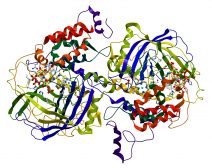Definition
noun, plural: choanoflagellates
A flagellate protozoan of the genera Monosiga and Proterospongia of the class Choanoflagellatea, characterized by possessing a protoplasmic collar around the base of the flagellum
Supplement
Choanoflagellates are free-living protozoans and exist as unicellular or in colonies. They are flagellate eukaryotes and are, according to evolutionary biologists, as the closest living ancestors of animals.
They are called choanoflagellates because each of them has one flagellum located apically and at the base of the flagellum is the conical transparent food-gathering collar made up of 30-40 actin-filled protrusions (referred to as microvilli). The microvilli gather bacteria and detritus, which are drawn by the flagellum and are later engulfed by the choanoflagellate cell.
Their cell body is ovoid or spherical in shape and about 3-10 µm in diameter. The flagellum helps not only for obtaining nourishment but also for propeling the choanoflagellate cell body in an aqueous medium. The flagellum pushes the body along the water current it generates. Nevertheless, many of them are solitary and sessile and may or may not have a stalk. Examples of choanoflagellate species are Monosiga brevicollis and Salpingoeca rosetta.
Word origin: Greek choane (a funnel) + flagellate (whip)
Synonym(s):
- craspedophyte
- Craspedophyceae
- collared flagellate
- Choanomonada
- Choanoflagellea
- Choanoflagellida
- Choanomonadea
- Choanoflagellata
See also:







